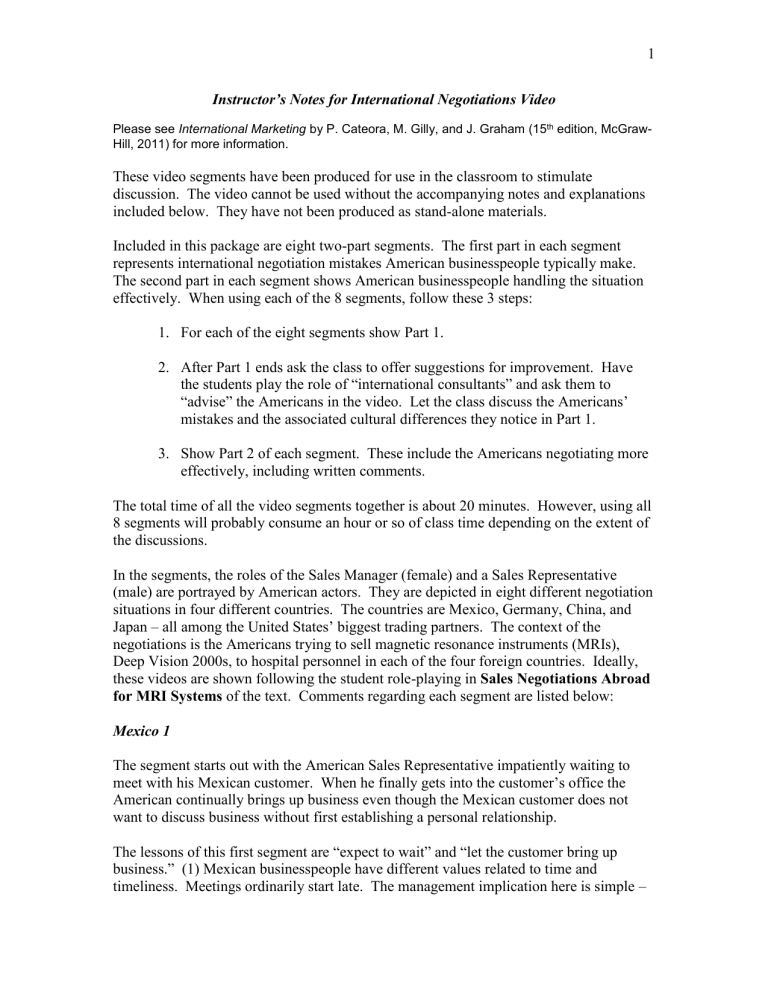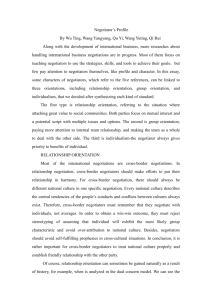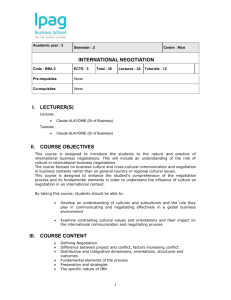NOTES TO ACCOMPANY VIDEOS FOR International Marketing

1
Instructor’s Notes for International Negotiations Video
Please see International Marketing by P. Cateora, M. Gilly, and J. Graham (15 th edition, McGraw-
Hill, 2011) for more information.
These video segments have been produced for use in the classroom to stimulate discussion. The video cannot be used without the accompanying notes and explanations included below. They have not been produced as stand-alone materials.
Included in this package are eight two-part segments. The first part in each segment represents international negotiation mistakes American businesspeople typically make.
The second part in each segment shows American businesspeople handling the situation effectively. When using each of the 8 segments, follow these 3 steps:
1.
For each of the eight segments show Part 1.
2.
After Part 1 ends ask the class to offer suggestions for improvement. Have the students play the role of “international consultants” and ask them to
“advise” the Americans in the video. Let the class discuss the Americans’ mistakes and the associated cultural differences they notice in Part 1.
3.
Show Part 2 of each segment. These include the Americans negotiating more effectively, including written comments.
The total time of all the video segments together is about 20 minutes. However, using all
8 segments will probably consume an hour or so of class time depending on the extent of the discussions.
In the segments, the roles of the Sales Manager (female) and a Sales Representative
(male) are portrayed by American actors. They are depicted in eight different negotiation situations in four different countries. The countries are Mexico, Germany, China, and
Japan – all among the United States’ biggest trading partners. The context of the negotiations is the Americans trying to sell magnetic resonance instruments (MRIs),
Deep Vision 2000s, to hospital personnel in each of the four foreign countries. Ideally, these videos are shown following the student role-playing in Sales Negotiations Abroad for MRI Systems of the text. Comments regarding each segment are listed below:
Mexico 1
The segment starts out with the American Sales Representative impatiently waiting to meet with his Mexican customer. When he finally gets into the customer’s office the
American continually brings up business even though the Mexican customer does not want to discuss business without first establishing a personal relationship.
The lessons of this first segment are “expect to wait” and “let the customer bring up business.” (1) Mexican businesspeople have different values related to time and timeliness. Meetings ordinarily start late. The management implication here is simple –
2 anticipate waiting and bring a book to read or paperwork to do. Don’t get impatient. (2)
In most countries around the world, good personal relationships must precede serious business discussions. In particular, Mexicans will want to share a meal and spend time getting to know you before getting down to business. It is worse than impolite to talk business before the customer is ready in any country, particularly in a “relationship oriented” culture like Mexico. Let them bring up business.
Mexico 2
The first part shows the Mexican buyers asking for what the Americans see as a
“ridiculously low” price. The key cross-cultural problem is differences in price padding practices. Americans tend not to pad prices much – Americans are in a hurry and start at a price pretty close to what they expect to get. In many other cultures, Mexico included, first offers are padded with much more room to maneuver. The Mexicans expect to spend time negotiating and leave room to make substantial concessions. When these two approaches meet in a cross-cultural negotiation, the Americans usually display one of two emotional reactions, they laugh (“You must be kidding”) or they get mad. The first reaction is usually seen as impolite and the second often leads to negotiations being terminated.
The lesson of the second segment is to “expect padded prices, ask questions.” Don’t laugh, don’t get mad, just ask questions. “How did you come up with those prices?”
Negotiators should focus on gathering information through asking good questions.
Germany 3
Here the two Americans are having a disagreement in front of their customers – bad form in any country. However, egalitarian Americans seem to suffer this affliction more frequently than negotiators from hierarchical countries or even Germans.
The lesson here is pretty obvious, but the point still needs to be made – “present one face.” When disagreements within your negotiation team crop up, take a break and settle them away from the table or in a negotiation sidebar. You may want to work through a central spokesperson as negotiators in many counties do.
It should be noted that there are two circumstances when controlling information by
“presenting one face” may not be optimal. (1) In a truly cooperative negotiation, creativity is enhanced by maximizing the number of ideas put on the table. Going through a spokesperson may limit the number of ideas broached and thus the allimportant creativity may be reduced. (2) A negotiation tactic often employed is the
“good guy, bad guy” routine. That is, one negotiator delivers the tough messages and the other focuses on maintaining a good relationship. We don’t recommend this approach, but negotiators should be aware of this commonly used psychological ploy.
Germany 4
3
This segment portrays two of the most common problems that arise when Americans and
Germans negotiate. (1) According to Germans, Americans tend to deliver “hype” rather than the data and details the Germans want. From the American point of view, if the customer needs great detail, it will be delivered when they ask for it. (2) German bluntness offends Americans, “This has been a waste of our time.” From the German point of view they are just delivering an honest and accurate evaluation – no
“cushioning” is involved in the German, low context style of communication. Americans use conversational cushioning and expect it to be used, even by Germans. This conflict in conversational style can cause great friction in otherwise cooperative business negotiations across the Atlantic.
The lesson here is two-fold – “don’t expect diplomacy” and “deliver details and data.”
Try to appreciate German frankness.
1 It is efficient. The key here is to back up all claims with data and references. Expect the German customers to ask for much more information than typically required in the States. For example, if you make a claim about your market share, show them the data you used to calculate it.
China 5
The problem
2
depicted here is a common one when Americans meet with Asians.
Americans tend to break up a complex negotiation task into a series or sequence of smaller tasks. Each smaller task is then addressed and solved in sequence. “Let’s settle price, then we can talk about delivery,” makes sense using such an approach. However, in Asian countries a more holistic approach is usual. All issues are discussed before any are settled. When the Western sequential approach meets the Eastern holistic approach,
Americans get quite frustrated. Since “closed issues” keep coming up again, Americans can’t measure progress and the entire negotiation process appears disorganized.
The lesson here is to go along with them and “consider all issues together.” Don’t make concessions until all the issues have been discussed. Use other measures of progress besides “counting the settled issues.” Ask them how things are proceeding. Look for a slowdown or a focusing in their questions. Notice more senior people being included on their side or more conversations among themselves in their native language.
China 6
The American sales manager responded with counteroffers – “a third year of the service contract at $15,000 and an extra year of warranty.” This is a mistake.
1 Checking the dictionary for the derivation of the word “frank” is quite interesting – apparently bluntness is an historical, cultural trait for Germans.
2 There’s a second problem portrayed here. Americans, particularly the inexperienced ones, don’t like it when foreigners discuss things in their native language. Americans feel left out or make all kinds of sinister attributions. However, usually such side conversations involve “getting the translation straight” or
“ they are having a disagreement among themselves.” Both these things are good for the American side, and such conversations should be encouraged.
4
A much better approach is to “ask questions before making counteroffers.” Keep them talking and focus on gathering information. You may not need to make a counteroffer at all, depending on their explanations.
Japan 7
In the first segment the American Sales Manager breaks the silence. This is a mistake.
Silences or gaps in the conversation are part of everyday conversations in Japan. But, this is not the case in the US. Generally Americans are uncomfortable with breaks in the conversation. Japanese silences may have a persuasive intent, but often they do not. The key here is to give the Japanese a chance to respond, let them break the silence. During such silent periods Americans can review their notes or mentally review how things are going. But, let them talk, and let them give you information. The fundamental lesson for
Americans negotiating with Japanese is, “keep your mouth shut and let them do the talking.” Focus on gathering information.
Japan 8
American negotiators get mad and they make threats. American experts on negotiation,
Chester Karrass for one, tell us that emotional responses have a place in negotiations.
Getting mad demonstrates the importance of the issue and demonstrates seriousness. In
Japan, getting mad ends negotiations and business relationships. In Japan, such messages are greatly cushioned by the Japanese indirect conversation and negotiation styles. Here the American Sales Manager is venting her emotions. Such an approach may work in
America, but this accomplishes much less than nothing in Japan.
Our advice here is to “avoid threats,” take a break, and “use informal channels” to deliver the tough messages. Informal channels of the sort depicted in the last scene work very efficiently in Japan. The information delivered through the junior person over dessert or a beer will be communicated accurately and quickly to the other Japanese team members.
This is how tough messages are delivered in Japan. This indirect approach may work, and it certainly saves face and preserves personal relationships. There are two rules for its use. (1) These junior members of the negotiation teams need to be friends ahead of time. Trust and pre-established personal relationships are key. (2) The channel has to remain informal. That is, the dinner conversation cannot be referred to at the negotiation table the next day. If you say, “Suzuki-san said last night…,” you won’t see Suzuki-san again.
Have fun with these in class!








